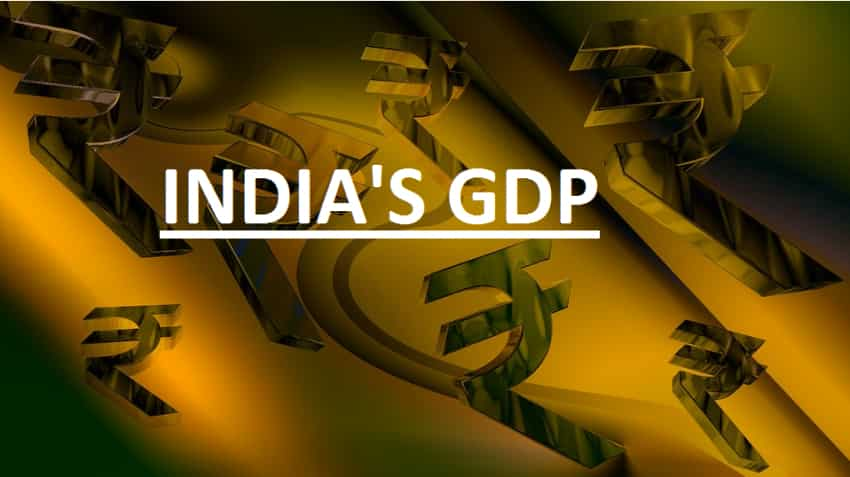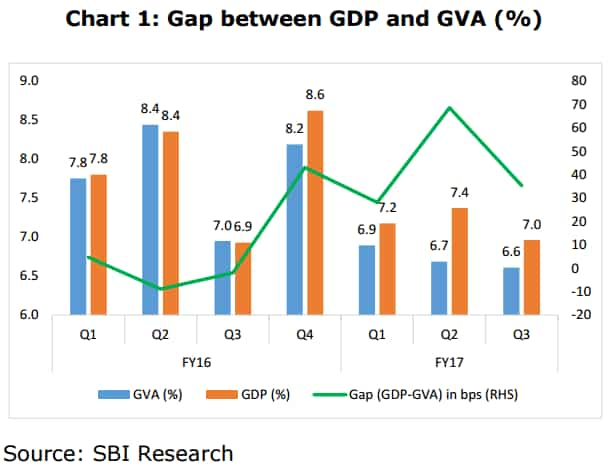Gap between India's GDP and GVA widens further
Teresa John of Nirmal Bang in a report said, “Our earlier estimates had assumed no significant difference between GVA and GDP as both had exhibited a converging trend in the earlier quarters. However, the CSO believes that higher indirect tax collection and lower subsidies have pushed up the indirect tax component of GDP, resulting in divergence between GVA and GDP. “

India's GDP numbers for the quarter ended Deecmber 31, 2016 came in as a surprise with 6.6% year-on-year (YoY) growth in terms of real gross value added (GVA) and 7% year-on-year (YoY) for real GDP, citing limited impact of demonetisation.
Many analysts believe that the performance of GVA and GDP for Q3 has showcased further separation within the two indicators.
GDP is an outcome of GVA plus net indirect taxes minus product subsidies.
Gross value added (GVA) takes into consideration the value of goods and services produced in an area, industry or sector of an economy. They account the highest share of a country's GDP.
Here is a performance of GDP and GVA from FY16 – till third quarter of FY17, which reflects the gap between the two indicators rising further:

In Q3, gap between GDP and GVA expanded by 40 basis points compared to contraction of 2 basis points in the similar period of last fiscal.
However, compared to previous quarter (Q2FY17) gap in third quarter was still lower. In Q2, there was a large gap of 70 basis points between GDP and GVA. However, this was before demonetisation came into existence.
In the first two quarter of last fiscal, GVA and GDP were on a similar levels but ended with a gap of 40 basis points in January – March 2016 period.
State Bank of India (SBI) said, “This is primarily due to huge increase in indirect tax collections during FY17.”
Kamalika Das and Niharika Tripathi analysts of ICICI Bank said, “We note that Q1 and Q2 growth numbers have been revised downward and on GVA basis they stand at 6.9% and 6.7% as compared to 7.3% and 7.1% earlier. Q3 real GVA growth slowed slightly to 6.6% and our own estimate of GVA for Q3 was lower at 5.7%.”
Data compiled by Ministry of Finance stated that from April - December 2016, indirect taxes increased by whopping 25% year-on-year (YoY) with revenue collections of Rs 6.30 lakh crore, utilising 81% of the Budget Estimates for FY17.
Among which, central excise net tax collections grew by 43% to Rs 2.97 lakh crore during the period compared to Rs 1.95 lakh crore a year ago last fiscal. Net collections of service tax for April - December 2016 stood at Rs 1.83 lakh crore, up by 24% versus Rs 1.48 lakh crore recorded in April - December 2015.
Teresa John of Nirmal Bang in a report said, “Our earlier estimates had assumed no significant difference between GVA and GDP as both had exhibited a converging trend in the earlier quarters. However, the CSO believes that higher indirect tax collection and lower subsidies have pushed up the indirect tax component of GDP, resulting in divergence between GVA and GDP. “

Sujan Hajra and Moumita Paul Samanta of AnandRathi said, “The CSO’s second advance estimate has retained its 7.1% growth for FY17. We expect the full-year growth to be higher, at 7.4%, mainly due to additional income from the income-disclosure scheme, which has not yet been captured.
SBI said, "As this component of taxes is going to increase the gap between GDP and GVA will also increase. Hence it is better to see GVA instead of GDP. "
Get Latest Business News, Stock Market Updates and Videos; Check your tax outgo through Income Tax Calculator and save money through our Personal Finance coverage. Check Business Breaking News Live on Zee Business Twitter and Facebook. Subscribe on YouTube.
RECOMMENDED STORIES

Looking for short term investment ideas? Analysts suggest buying these 2 stocks for potential gain; check targets

Rs 3,500 Monthly SIP for 35 years vs Rs 35,000 Monthly SIP for 16 Years: Which can give you higher corpus in long term? See calculations
03:33 PM IST









 Economy to improve in coming quarters, lower Q2 growth a temporary blip: Nirmala Sitharaman
Economy to improve in coming quarters, lower Q2 growth a temporary blip: Nirmala Sitharaman October-March GDP numbers expected to be much better: Economic Affairs Secretary
October-March GDP numbers expected to be much better: Economic Affairs Secretary  At 7-quarter low, has GDP growth bottomed out for now?
At 7-quarter low, has GDP growth bottomed out for now?  GST collections up over 8% at Rs 1.82 lakh crore in November
GST collections up over 8% at Rs 1.82 lakh crore in November GDP growth slows to 7-quarter low of 5.4%; here is what economists say
GDP growth slows to 7-quarter low of 5.4%; here is what economists say